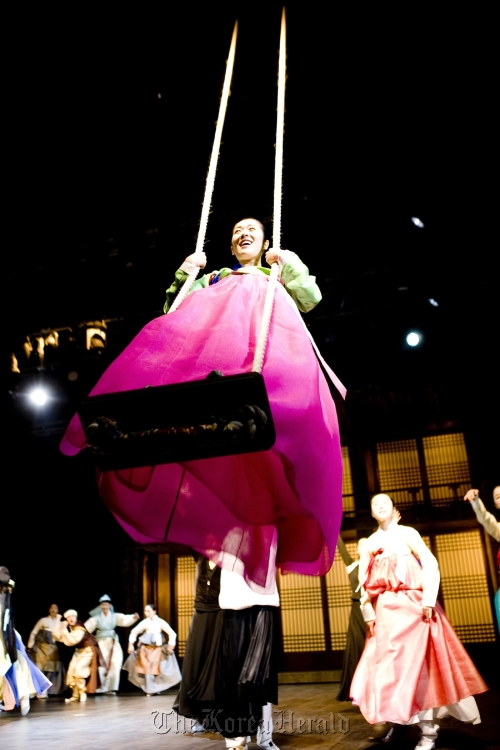Foreigners flock to Chongdong Theater’s dance and music
As the clear yet sorrowful tune of a “haegeum,” a traditional Korean musical instrument, resonated throughout Chongdong Theater in Jeong-dong, central Seoul, on Tuesday evening, the audience grew quiet and all eyes were set on stage.
A soft light focused on a corner of the stage where an orchestra was set. The orchestra consisted not of violins and cellos but of Korean traditional musical instruments. The audience, of which about 80 percent were foreigners, applauded in admiration.
Then the music turned more upbeat and a crew of dancers decked in colorful “hanbok,” or Korean traditional costumes, gracefully twirled onto the stage for scene one, “Dano Festival,” a traditional spring festival, of this year’s first performance of “Miso.”
“Miso,” translated as “beautiful smile,” is the theater’s original performance which offers a compact presentation of everything Korean culture first-timers could wish for. It blends ten different kinds of traditional dances, five traditional games and a wedding ritual into the main story line based on a well-known folktale, “The Tale of Chunhyang.”
As the clear yet sorrowful tune of a “haegeum,” a traditional Korean musical instrument, resonated throughout Chongdong Theater in Jeong-dong, central Seoul, on Tuesday evening, the audience grew quiet and all eyes were set on stage.
A soft light focused on a corner of the stage where an orchestra was set. The orchestra consisted not of violins and cellos but of Korean traditional musical instruments. The audience, of which about 80 percent were foreigners, applauded in admiration.
Then the music turned more upbeat and a crew of dancers decked in colorful “hanbok,” or Korean traditional costumes, gracefully twirled onto the stage for scene one, “Dano Festival,” a traditional spring festival, of this year’s first performance of “Miso.”
“Miso,” translated as “beautiful smile,” is the theater’s original performance which offers a compact presentation of everything Korean culture first-timers could wish for. It blends ten different kinds of traditional dances, five traditional games and a wedding ritual into the main story line based on a well-known folktale, “The Tale of Chunhyang.”

It is a love story between Chunhyang, the most beautiful girl in Namwon, North Jeolla Province, and Mongryong, a young elite. The two meet at the Dano Festival and fall in love but have to separate when Mongryong sets out to Seoul to take the state exam. While he is away, Byeon Hakdo, the new magistrate in town, is taken by Chunhyang and tries to make her his mistress. Chunhyang refuses and is imprisoned. Mongryong, who, in the meantime, has become a Secret Royal Inspector, comes back to town and saves Chunhyang, marries her and punishes Byeon.
The show was first staged in 1997 under a different name, “Traditional Performance Stage,” and with a slightly different repertoire. The title “Miso” was established in 2008 and “The Tale of Chunhyang” form took hold last year.
“The plot is basically the same as last year but this year we changed the order of the scenes and upgraded some parts so that the audience can more fully understand the story,” said Shin Gi-na, an official at the theater’s performance planning division.
“We added Byun Hakdo’s solo dance to show that his love is meaningful in a way as well. And we moved the party and game-playing scene to the end, after the marriage scene, so the audience can participate in them more freely without having to continue with the story afterward.”
The final party scene with “samulnori,” a traditional percussion performance, is the highlight of the show. The audience did not seem to be the least irritated by the ear-deafening clanks of “jing,” or a small gong, or the loud “buk,” or a large drum, drumming sounds. They cheered and followed the performers outdoors where the party continued.
More than 650,000 have watched the show in the last 14 years. It has been very popular especially among foreigners ― last year, 77 percent of the 79,640 visitors were non-Koreans. The show was performed overseas numerous times as well.
In response to the enthusiastic response, Chongdong Theater was dedicated to exclusively staging “Miso” last year. A similar theater will open in Gyeongju in North Gyeongsang Province in July.
The show has been refined and polished over the years, to make it more Korean and foreigner-friendly. It added a traditional Korean vibe to the details as much as possible, like having the staff decked in hanbok carry “cheongsachorong,” or a traditional Korean lantern with a red and blue silk shade, when guiding the visitors to their seats, for instance.
There are very few spoken lines throughout the whole performance, taking into account its audience of such diverse nationalities. Instead, actors hold up signs written in five different languages ― Korean, English, Japanese, Cantonese and Mandarin ― at crucial moments in the story.
Those who are not familiar with the folktale, however, might find it hard to keep up with the show, especially since the story development was speeded up to finish the performance in less than an hour before the audience-participating party scene starts. A number of errors in the English subtitles on the screen at the start of the show should be amended for better understanding as well.
“Miso” is showing as an open run at Chongdong Theater in Jeong-dong, central Seoul. Shows are held at 4 p.m. and 8 p.m. everyday except for Monday. Tickets range from 30,000 won to 50,000 won. For more information, call (02) 751-1500 or visit www.koreamiso.com.
By Park Min-young (claire@heraldcorp.com)







![[Graphic News] More Koreans say they plan long-distance trips this year](http://res.heraldm.com/phpwas/restmb_idxmake.php?idx=644&simg=/content/image/2024/04/17/20240417050828_0.gif&u=)
![[KH Explains] Hyundai's full hybrid edge to pay off amid slow transition to pure EVs](http://res.heraldm.com/phpwas/restmb_idxmake.php?idx=644&simg=/content/image/2024/04/18/20240418050645_0.jpg&u=20240419100350)







![[KH Explains] Hyundai's full hybrid edge to pay off amid slow transition to pure EVs](http://res.heraldm.com/phpwas/restmb_idxmake.php?idx=652&simg=/content/image/2024/04/18/20240418050645_0.jpg&u=20240419100350)

![[Today’s K-pop] Illit drops debut single remix](http://res.heraldm.com/phpwas/restmb_idxmake.php?idx=642&simg=/content/image/2024/04/19/20240419050612_0.jpg&u=)